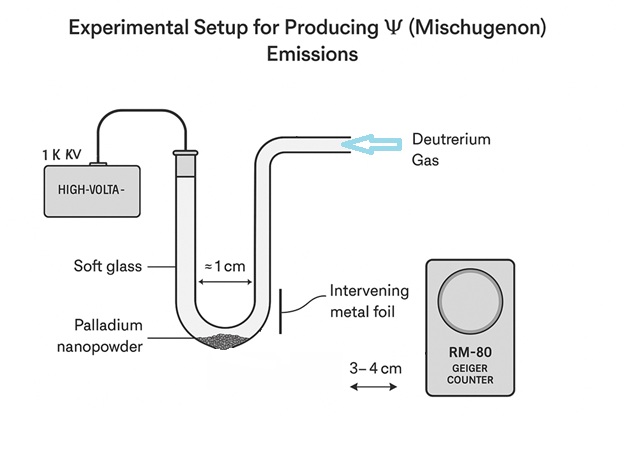
Einstein’s Aether? DIY Fetching Ψ⁵ Quanta From The 5th Dimension Of Quantum Gravity
Tabletop experiment opens doorway into the Graviton Aether and offers the first direct access to quantum gravity.
GAC5D Quanta and the Birth of the Mischugenon Hypothesis
My 35+ years of experiments have led me to development of the Gravitational Aether Casimir in 5 Dimensions (GAC5D) model. This lifetime of work has brought with it not only a new theoretical framework for understanding vacuum structure and nuclear coherence, but also an emergent class of anomalous observations that traditional physics cannot explain. One of the most striking of these is the appearance of unusual radiation in highly coherent, deuterium-loaded metal systems, particularly those involving nanometric palladium powders subjected to cold cathode glow discharge in pure deuterium gas.
These experiments, performed over decades and refined through countless iterations, began revealing an enigmatic signal: a pulse of radiation that passed through thick glass, multiple centimeters of air, and a mica window, yet was unimpeded by materials that should stop alpha or beta particles. Even more astonishing, the introduction of metallic foils—especially copper and silver—between the emission source and the detector produced dramatic increases in the GM count rate. Silver, in particular, often saturated the detector. Neutrons were not the cause for if they were my dose would have been measured in thousands of kilorem, however, I lived to share this with you. There was no evidence of gamma emissions.
These observations pointed to the emergence of what Edward Teller, one of my collaborators, with characteristic humor and prescience, dubbed the “Mischugenon”: a mischievous, neutron-like entity that did not follow the behavior of any known particle. We now propose that the mischugenon is a manifestation of what we call GAC5D quanta, denoted here as Ψ⁵—quasi-particles or vacuum excitations that arise from transitions within the 5-dimensional aether field predicted by the GAC5D model.

RIP Edward
When I sheepishly described to Edward Teller my method using old school Geiger counters and filters to detect neutron-like radiation, from a simple low-powered cold cathode deuterium gas and palladium nanopowder experiments he dismissed my apology with encouragement: “Don’t apologize to me for the methods and instruments you have used to produce and discover these incredible emissions. You have used the same methods we used so long ago when we first discovered and explored the neutron.” His validation collapsed the decades between our eras of exploration.
GAC5D quanta, or Ψ⁵, are not standard particles. They do not possess fixed mass, charge, or interaction cross-sections in the familiar 4D spacetime. Instead, they are localized ruptures or stress-relief events within the coherent 5D vacuum. They are emitted when aether-coupled nuclear states—particularly metastable or transitionary configurations like 3He and 4He—release thermal energy at Joules/sec and not as photons or standard particles, but as localized aether field perturbations. These perturbations—Ψ⁵ mischugenons—travel unimpeded through ordinary matter until encountering materials with electronic or nuclear configurations that can transduce their vacuum mode into classical ionizing radiation. This explains the sharp detection contrast seen between stainless steel (null), copper (moderate), and silver (extreme enhancement).
In the broader context of the GAC5D model, we may understand Ψ⁵ not as particles in the conventional sense, but as transient disturbances or wave-packets in the graviton-rich 5D aether. They may be thought of as localized shock fronts or soliton-like energy carriers, briefly bridging the 5D vacuum with 4D spacetime through a coherently destabilized region. Their apparent neutron-like interaction with matter is not due to nuclear force coupling but arises from aether-mediated interactions with certain nuclear or electronic geometries. In this sense, Ψ⁵ quanta are dimensional emissaries from the realm of quantum gravity—revealing how vacuum structure itself can participate in energy transactions normally confined to particles.
To anchor this interpretation, we may write a field expression for Ψ⁵ as:
Ψ⁵(x^μ) ≈ ∇ν G^{μν}{(5D)} + δℰ_coh(x^μ) · Θ(t − t_c)
Here, Ψ⁵(x^μ) is the field excitation observable in 4D spacetime; G^{μν}_{(5D)} is the 5D gravitational field tensor; ∇_ν is the covariant derivative describing field divergence; δℰ_coh(x^μ) is the local energy released by coherence collapse (such as from metastable ³He*); and Θ(t − t_c) is a Heaviside step function marking the moment of decoherence. This equation reflects how Ψ⁵ quanta emerge as a response to vacuum curvature dynamics in a GAC5D-active environment.
Experimental Method for Producing Ψ⁵ (Mischugenon) Emissions
To encourage replication of this effect so that we may all get on with life in our quantum gravity universe the experimental setup that produces Ψ⁵ emissions is described here in detail:
A simple glow discharge tube is constructed from soft, standard glass tubing approximately 1 cm in diameter—commonly used for neon signage. A small quantity (approximately 0.25 cc) of palladium nanopowder, with particle sizes in the range of 30–50 nm, is used as the reactive material.
The tube is first evacuated to high vacuum and baked using an RF induction heater to eliminate contaminants. Several heat-and-pump cleaning cycles are performed.
Once the test tube is cleaned, the palladium powder is introduced into a U-bend at the base of the tube. The system is again evacuated to approximately 10⁻³ Torr. It is then repeatedly flushed and filled with high-purity deuterium gas to ensure saturation and purity.
After the final D₂ fill, the electrodes (standard neon tube electrodes) are connected to a common 10 kV neon sign transformer. The D₂ pressure is gradually reduced until the tube begins to exhibit a stable deuterium glow discharge. The tube is then sealed (fused closed), and the active experiment begins.
The sealed tube is positioned vertically in a clamp on a laboratory bench, with the U-bend containing the palladium powder located at the bottom and near the detection system. A GM pancake detector (Aware Electronics RM-80 or equivalent) is positioned approximately 3–4 cm from the outside of the glass envelope, centered on the Pd region (bottom of the U-tube). This configuration allows Ψ⁵ emissions to pass through the glass, air gap, and mica window into the detector.

Within minutes of initiating the discharge, the detector begins registering elevated count rates, often persisting for hours to days. To examine and enhance the Ψ⁵ signal, thin metal foils (approximately 100 µm thick) can be interposed between the tube and the detector. Copper and silver foils are particularly effective, with silver producing substantial amplification of the signal. Stainless steel typically shows no enhancement and is an effective null. Data is recorded using standard PC interfaces linked to the GM detector. The GM registers ~28cps with the tube powered down, it emits ~60-80cps with the power on, with stainless steel foil in between the U-Tube and the GM device the count rate remains at 60-8-cps. When a copper foil is inserted in the gap the count rate jumps to ~300-700cps. When a Silver foil is inserted in the gap the count rate rapidly rises to thousands of cps and soon saturates the GM counter. Welcome to the world of Quantum Gravity and Cold Fusion!
From within the GAC5D framework, the mischugenon serves as an experimental signature of vacuum coherence rupture. It validates the theory’s prediction that vacuum structure is not passive, but actively participates in energy transitions when coherent conditions exist. The vacuum in these domains is not empty—it is a structured, reactive, and transductive medium. These findings not only support the GAC5D model but also offer one of its most promising empirical handles.
By documenting and reproducing these mischugenon effects in varied GAC5D-active configurations, we now have a foundation for probing the dynamics of vacuum-matter interaction directly. The mischugenon is not merely a curiosity—it is a probe, a fingerprint, and perhaps the first laboratory-scale window into the aether that Einstein hoped would one day be reclaimed by physics.
As Teller might say, it’s just crazy enough to be true.
If you have Ed’s quantum cell number feel free to give him a call I am sure he will want to help!